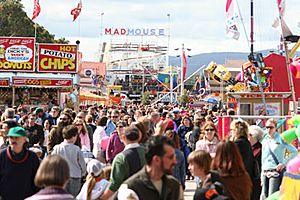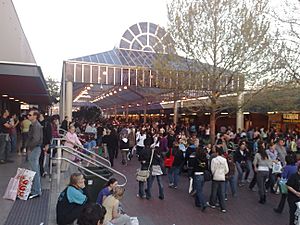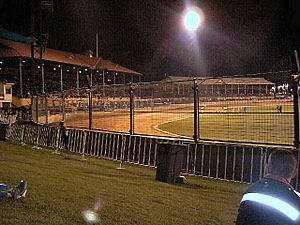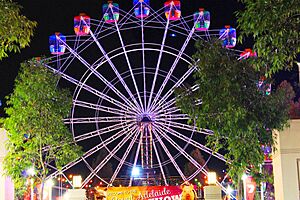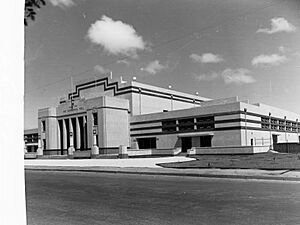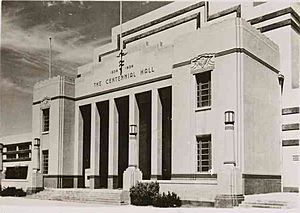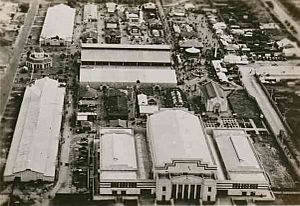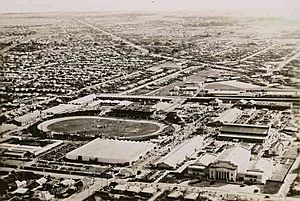Adelaide Showground facts for kids
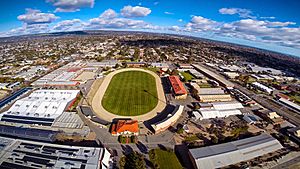 |
|
| Location | Wayville, South Australia |
|---|---|
| Coordinates | 34°56′48″S 138°35′12″E / 34.94667°S 138.58667°E |
| Capacity | 14,000 (current) 35,000 (1930s) |
| Owner | Royal Agricultural and Horticultural Society of South Australia |
| Operator | Royal Agricultural and Horticultural Society of South Australia (showground) Various (speedway) |
| Opened | 1925 (showground) 1926 (speedway) 1934 (harness racing) |
| Major events | Royal Adelaide Show Australian Solo Championship World Series Sprintcars West End Speedway International Castrol Sidecar Cup Supanova Pop Culture Expo Inter Dominion |
| Main Arena / Speedway | |
| Surface | dirt and sand mix |
| Length | 0.316 mi (0.510 km) |
The Adelaide Showground is a super popular place in Adelaide. It hosts many exciting events, including the famous Royal Adelaide Show. People also know it as the Wayville Showgrounds.
This big event space is in Wayville, a suburb just south of Adelaide's city center. It is surrounded by important roads and a railway line. The Royal Agricultural and Horticultural Society of South Australia (RAHS) has managed the Showground since the 1920s. The Royal Show first moved to this location in 1925.
The Showground has one of the largest indoor exhibition areas in the Southern Hemisphere. It hosts over 140 exhibitions and conferences every year. Even university exams for the University of Adelaide and University of South Australia happen here.
In 2006, the official name of the Showground changed. It went from 'Royal Adelaide Showground' to simply 'Adelaide Showground'.
In 2008, a huge solar power system was added to the new Goyder Pavilion. This was the biggest rooftop solar setup in Australia at the time. It cost $8 million and covered 10,000 square meters with solar panels. This system creates enough electricity to power 200 homes and helps reduce pollution. Because of its size, the Adelaide Showground is even registered as a power station!
Contents
Main Arena: A Hub for Events
The main arena at the Adelaide Showground is a very important part of the venue. In the past, during the 1920s and 1930s, it could hold up to 35,000 people. Today, it can still welcome about 14,000 visitors. This arena has seen many different types of events over the years.
Speedway Racing History
From 1926 to 1934, the main arena was famous for speedway racing. It was even called the "Speedway Royal." Some people say it was the "birthplace of Australian Speedway." The track was shaped like an egg and was made of a dirt and sand mix over concrete. It was 510 meters long and known as one of Australia's fastest speedways. In 1928, it was even called "The World's Fastest Dirt Track Speedway."
Speedway racing stopped at Wayville after 1934 for a long time. One reason might have been that the track was also used for harness racing, and speedway races made the track too rough. Another reason could have been the Great Depression, which made it hard for promoters to afford events.
Speedway racing did not return to Wayville until 1986, which was 52 years later! This return brought exciting international races with top motorcycle speedway riders. The Showground has also hosted the Australian Solo Championship several times, including in 1928, 1929, 1930, 1931, 1932, and again in 2002.
Many world-famous speedway riders have competed at Wayville. These include champions like Ivan Mauger from New Zealand and Hans Nielsen from Denmark. Australian stars like Jason Crump and Leigh Adams also raced here.
The Adelaide Showground holds a special record in Australian speedway. It had the longest wait between hosting Australian championships. There was a 70-year gap between the 1932 and 2002 Australian Solo Championships held at Wayville.
Other Uses of the Main Arena
The main arena has been used for more than just speedway. It was once the home ground for the West Adelaide Football Club from 1927 to 1939. They even won a championship in their first year there!
From 1934 to 1973, the 510-meter track was also used for harness racing in Adelaide. This is a type of horse racing where horses pull a driver in a two-wheeled cart. Wayville hosted the important Inter Dominion championships six times during this period.
Today, besides the Royal Adelaide Show, the main arena hosts other big events. These include music festivals like the Big Day Out, Monster Truck shows, and Motocross events. The showbag hall, another part of the Showground, is often used for Adelaide Roller Derby games. In 2021, a pavilion at the Showground was even used to help vaccinate people against the COVID-19 virus.
Centennial Hall: A Historic Building
Centennial Hall was a very important building at the Showground. It was built to celebrate 100 years since the founding of South Australia. It opened on March 20, 1936, and was a great example of 1930s Art Deco style architecture.
This historic building hosted many memorable events. For example, The Beatles played their first four Australian concerts here in June 1964. The Rolling Stones also performed in Centennial Hall in February 1966.
Unfortunately, the building developed a problem called "concrete cancer." This made it unsafe, and it had to close after the 2005 Royal Show. Demolition of Centennial Hall began in July 2007.
Comparing Showgrounds Across Australia
The Adelaide Showground's main arena is special because it still looks much like it did when it first opened. This is similar to the Brisbane Exhibition Ground. Other major city showgrounds in Australia have changed a lot. For example, the old Sydney Showground is now a film studio. The Perth and Melbourne Showgrounds have also seen their main arenas redeveloped or demolished.


